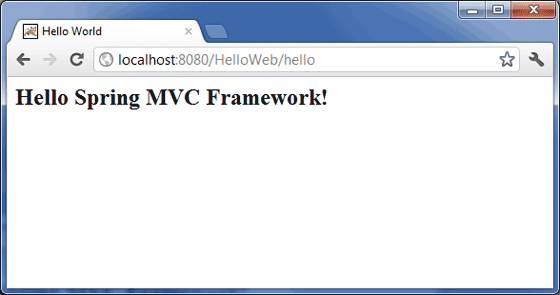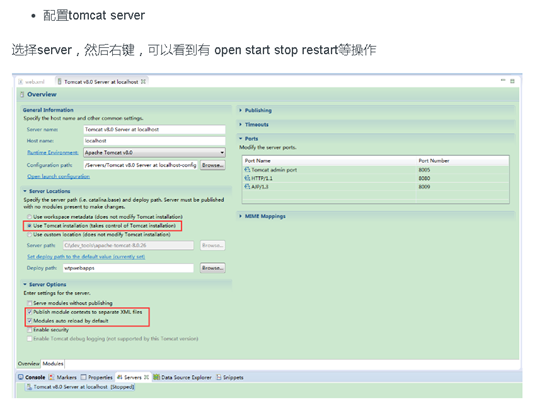下面的例子说明了如何使用 Spring MVC 框架来编写一个简单的基于 web 的 Hello World 应用程序。下面让我们使用 Eclipse IDE,然后按照下面的步骤使用 Spring 的 Web 框架来开发一个动态 Web 应用程序:
步骤 | 描述 |
1 | 创建一个名称为 HelloWeb 的动态 Web 项目,并且在已创建的项目的 src文件夹中创建一个包 com.tutorialspoint。 |
2 | 将上面提到的 Spring 和其他库复制到文件夹 WebContent/WEB-INF/lib中。 |
3 | 在 com.tutorialspoint 包下创建一个 Java 类 HelloController。 |
4 | 在 WebContent/WEB-INF 文件夹下创建 Spring 的配置文件 Web.xml和 HelloWeb-servlet.xml。 |
5 | 在 WebContent/WEB-INF 文件夹下创建名称为 jsp 的子文件夹。在这个子文件夹下创建一个视图文件 hello.jsp。 |
6 | 最后一步是创建所有的源代码和配置文件的内容,并导出该应用程序,正如下面解释的一样。 |
这里是 HelloController.java 文件的内容:
package com.tutorialspoint;
import org.springframework.stereotype.Controller;
import org.springframework.web.bind.annotation.RequestMapping;
import org.springframework.web.bind.annotation.RequestMethod;
import org.springframework.ui.ModelMap;
@Controller
@RequestMapping("/hello")
public class HelloController{
@RequestMapping(method = RequestMethod.GET)
public String printHello(ModelMap model) {
model.addAttribute("message", "Hello Spring MVC Framework!");
return "hello";
}
}
下面是 Spring Web 配置文件 web.xml 的内容
<web-app id="WebApp_ID" version="2.4"
xmlns="http://java.sun.com/xml/ns/j2ee"
xmlns:xsi="http://www.w3.org/2001/XMLSchema-instance"
xsi:schemaLocation="http://java.sun.com/xml/ns/j2ee
http://java.sun.com/xml/ns/j2ee/web-app_2_4.xsd">
<display-name>Spring MVC Application</display-name>
<servlet>
<servlet-name>HelloWeb</servlet-name>
<servlet-class>
org.springframework.web.servlet.DispatcherServlet
</servlet-class>
<load-on-startup>1</load-on-startup>
</servlet>
<servlet-mapping>
<servlet-name>HelloWeb</servlet-name>
<url-pattern>/</url-pattern>
</servlet-mapping>
</web-app>
下面是另一个 Spring Web 配置文件 HelloWeb-servlet.xml 的内容
<beans xmlns="http://www.springframework.org/schema/beans"
xmlns:context="http://www.springframework.org/schema/context"
xmlns:xsi="http://www.w3.org/2001/XMLSchema-instance"
xsi:schemaLocation="
http://www.springframework.org/schema/beans
http://www.springframework.org/schema/beans/spring-beans-3.0.xsd
http://www.springframework.org/schema/context
http://www.springframework.org/schema/context/spring-context-3.0.xsd">
<context:component-scan base-package="com.tutorialspoint" />
<bean class="org.springframework.web.servlet.view.InternalResourceViewResolver">
<property name="prefix" value="/WEB-INF/jsp/" />
<property name="suffix" value=".jsp" />
</bean>
</beans>
下面是 Spring 视图文件 hello.jsp 的内容
<%@ page contentType="text/html; charset=UTF-8" %>
<html>
<head>
<title>Hello World</title>
</head>
<body>
<h2>${message}</h2>
</body>
</html>
最后,下面是包含在你的 web 应用程序中的 Spring 和其他库。你仅仅需要将这些文件拖拽到 WebContent/WEB-INF/lib 文件夹中。
- commons-logging-x.y.z.jar
- org.springframework.asm-x.y.z.jar
- org.springframework.beans-x.y.z.jar
- org.springframework.context-x.y.z.jar
- org.springframework.core-x.y.z.jar
- org.springframework.expression-x.y.z.jar
- org.springframework.web.servlet-x.y.z.jar
- org.springframework.web-x.y.z.jar
- spring-web.jar
一旦你完成了创建源代码和配置文件后,导出你的应用程序。右键单击你的应用程序,并且使用 Export > WAR File 选项,在 Tomcat 的 webapps文件夹中保存你的 HelloWeb.war 文件。
现在启动你的 Tomcat 服务器,并且确保你能够使用标准的浏览器访问 webapps 文件夹中的其他 web 页面。现在尝试访问该 URL http://localhost:8080/HelloWeb/hello。如果你的 Spring Web 应用程序一切都正常,你应该看到下面的结果:

你应该注意,在给定的 URL 中,HelloWeb 是这个应用程序的名称,并且 hello 是我们在控制器中使用 @RequestMapping("/hello") 提到的虚拟子文件夹。当使用 @RequestMapping("/") 映射你的 URL 时,你可以使用直接 root,在这种情况下,你可以使用短 URL http://localhost:8080/HelloWeb/ 访问相同的页面,但是建议在不同的文件夹下有不同的功能。
404
